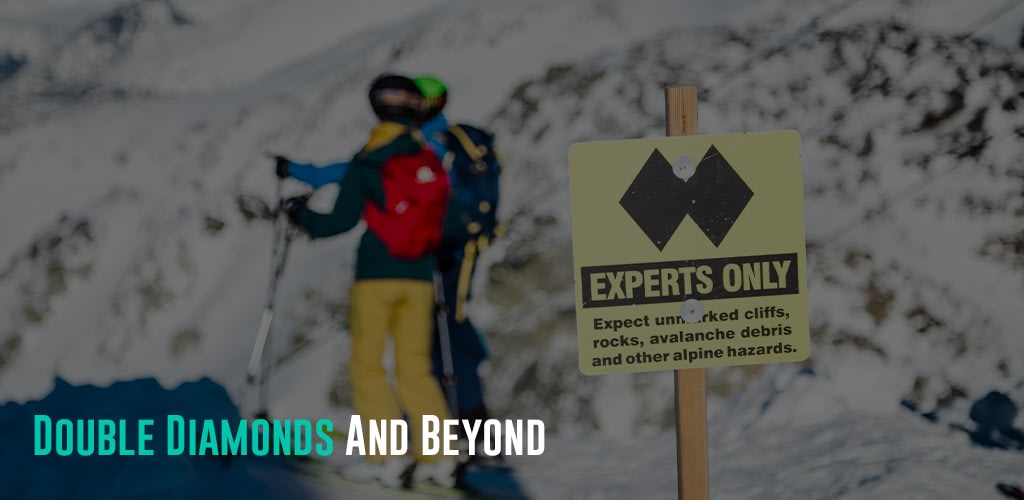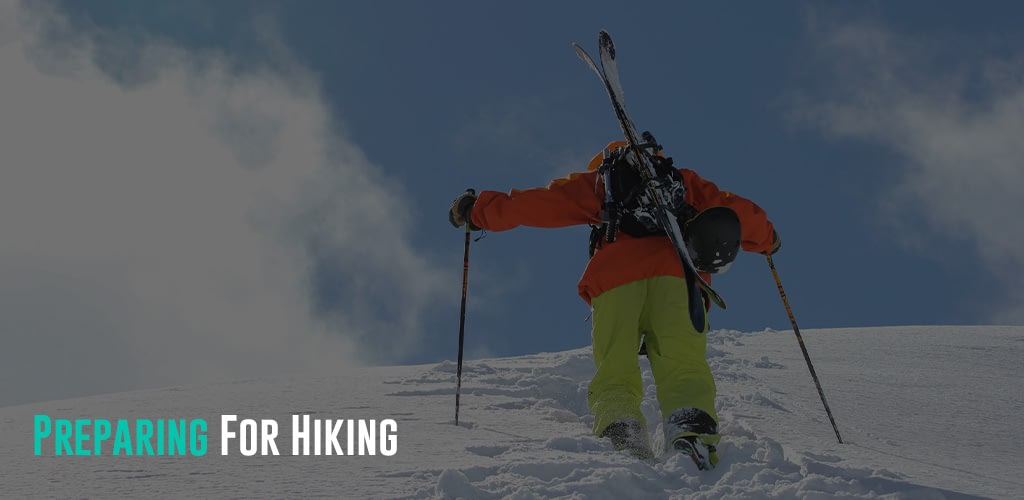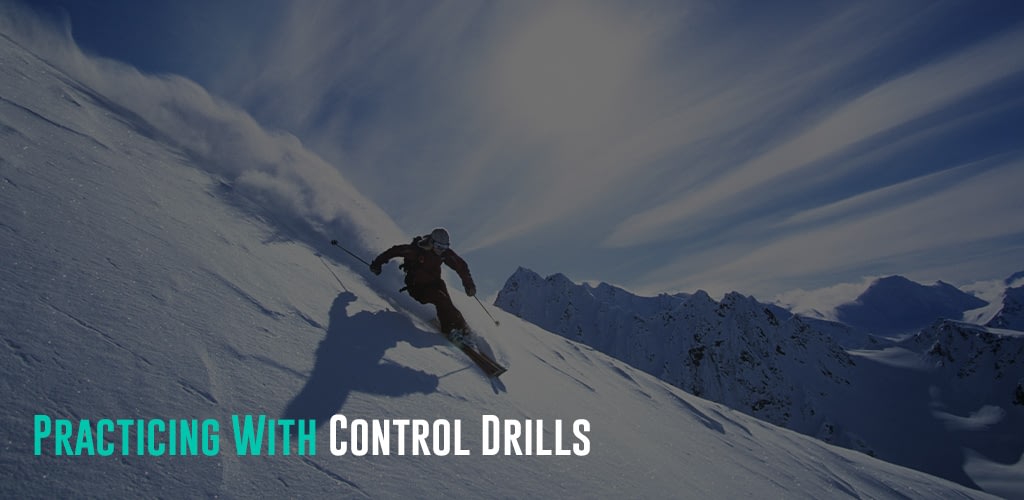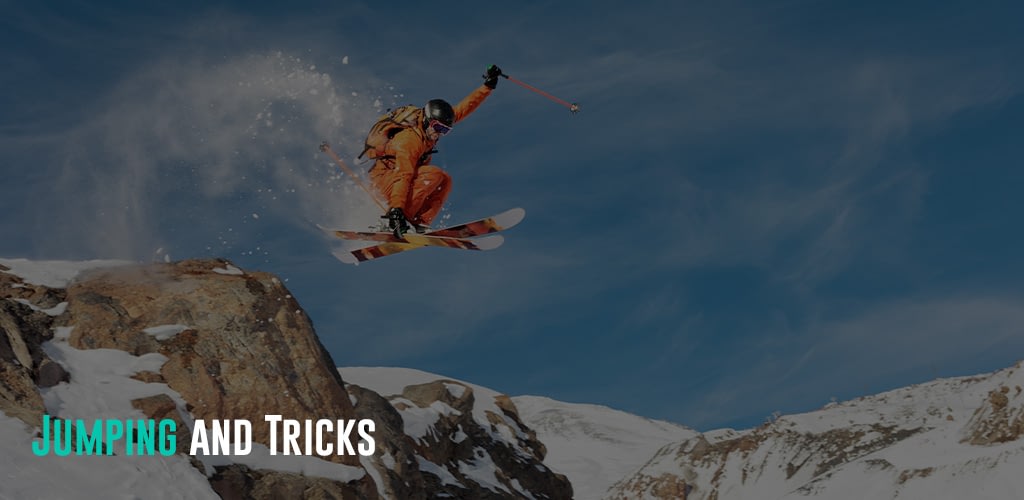As an advanced skier, you embrace double diamonds and can safely go into the backcountry of resorts and navigate through the debris and trees. Each run begins to feel like its own unique adventure, and you are constantly challenged to use all the skills and confidence you built to survive and thrive. Welcome to advanced skiing! Let’s dive in and explore how to excel as an advanced skier.
Be sure to check out our intermediate guide in the series here.
Featured Image Source
Double Diamonds And Beyond

Runs on the mountain are rated by the ski patrol teams’ difficulty in performing rescue operations. Given this is more of a safety rating, it can translate to being very steep and challenging runs. Failure to execute can mean you could have great potential for injury. When you start doing single, double-diamond, or more challenging runs, you should never jump straight to these runs. You will bring your combined experience and skillset when ready for the challenge through the many iterations of learning on other runs. Double diamonds become doable.
From my experience, there are not many others doing double diamonds. Suddenly, many of the runs will seem a lot less crowded. If there are others, allow everyone to go down one at a time to give everyone a space for safety. With that said, you can open up your speed and utilize all your skills on the double diamond with generally little fear of hitting others. Generally, speed is no issue on double diamonds.
They are steep enough that when your boards are pointing down the mountain, you will gain speed very fast. A lot of the skillset changes to needing to control your speed rapidly with the shapes and turns of the mountainside. A lot of this translated to forced and quick “short” turns. This effectively translates to slight hops with the board from one side to the other. It’s the same basic carving motions, except much faster, leading to slight hopping motions from side to side.
Avalanches
One consideration with double diamonds is that they receive less traffic than other runs, and they are steep enough that avalanches become a concern from snow buildup. For this reason, it helps to take an avalanche training class to help create some awareness.
Or at least buy and practice using an avalanche beacon transmitter. In the event there is an avalanche, and you are caught, the avalanche beacon paired with buddies you are skiing with will be critical to survival. Ski patrol does their best to mark and preemptively block off areas with avalanche danger. However, I read about folk who died from avalanches in the news every year. Therefore, it is best to be prepared.
Preparing For Hiking

Many lifts on mountains don’t always go to the top of the mountain, creating many logistical problems due to erosion and intense winds. You’ll often have to get off your boards and hike to get to many of the most extreme runs at the resort. These hikes could be extended, steep, and on a very narrow path can be pretty dangerous. When doing these hikes, it is essential always to keep a good balance as you may get hit with random gusts of wind, to which you need to brace and have sound footing.
For long hiking, I will generally bring velcro straps to tie my skis together and let them sit on my back with a cross-chest strap that keeps the skies stable and out of the way. I will hold my ski poles in one hand as a point of contact for balance. For snowboarders, you can push your snowboard into the snow for some extra balance.
Move slowly but steadily. If you pass others or need to let others pass you, step off the trail or ask the other person to step off to let you pass. You’ll stay warm as climbing uphill is not an easy thing. It will generate quite some body heat.
Practicing With Control Drills

As an advanced skier, it is vital to start paying attention to the finer details of your movements. From carves to short turns and tricks, it’s time to start practicing control drills to hone your finer movements. One control drill I tend to do for skis, especially on single diamonds or blue runs, is going downhill with motion and adding in helicopter spins. To spin while in motion takes excellent edge control, even while backward, which forces you to break some comfort zones. Also, be sure to practice jumps on these less steep runs as it gets you more exposure to uneven and less predictable jump surfaces. Just be sure always to know where the jump is going.
For snowboarders, I am not super familiar with various control drills to practice, but it is essential to research and find some control drills that work for you and practice them. Here are some excellent techniques that should be able to get you started.
Jumping and Tricks

Lastly, let us talk about more advanced jumping and getting into tricks. I am not talking about Olympian-style jumping here, but being able to identify terrain jumps in the wild, send them off, and execute a solid landing. I’d also throw in medium to large jumps in the trick parks. At this point, it’s good to start doing bigger jumps and building your comfort with jumping.
Spins
Also, tricks! To start with tricks, go back to the extra small jumps. You can expect to fall many times practicing tricks, but the fine control drills I mentioned earlier will start helping you here. To start, you want to practice a 180. For skiers, this means landing backward. As you begin jumping, as you ollie, you’ll also spring into a twist, enough to twist you to the 180 positions. Again, it will take practice to experience and feel how much pressure this needs. The 180 is a good starting point and is quite a bit easier for snowboarders as they don’t need to land backward.
Once you feel comfortable with the 180, start going for the 360. The 360 requires quite a bit of force on the extra small jumps. Again, it will take a bit to get the right amount of pressure to execute a 360, but practicing repeatedly will help you get the right feel.
Also, another easy trick to start practicing is the board grab. It is easier than the 180, and if you get enough air time will feel natural. You scrunch up in the air just as you do before you land and ollie except in the air and then grab your boards. The board grab! Now you’ll look quite styling; believe it or not, all these tricks help advance your fine control skills, leading to more confidence and stability on the double diamonds.
Conclusion
Start planning your trip now with Travel-Wise’s free trip-planning tools to have you on your way to your destination faster than ever!

